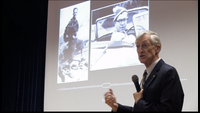Canais: A Universidade do Porto, Ciências Exatas e da Engenharia
John Mather (Prémio Nobel da Física 2006) na FCUP
- 1600
- 0
Autor TVU.
Descrição John Mather, Prémio Nobel da Física em 2006, visitou dia 5 de novembro, a Faculdade de Ciências da Universidade do Porto (FCUP), onde falou sobre “From the Big Bang to now, Observing the Universe with the James Webb Space Telescope”.
Assista à entrevista que John Mather deu à TVU.
Intervenientes John Mather e Orfeu Bertolami
Entidades FCUP, U.Porto
Localização FCUP
Línguas Português, Inglês
Data 2015-11-05
Conteúdos do mesmo Canal
-

Conferência "The Wiki State" por Gary Chapman (UT Austin)
Conferência The Wiki State: Transforming Government With New Internet Tools", realizada no âmbito do programa UT Austin-Portugal. Proferida pelo Prof. Gary Chapman da Universidade do Texas em Austin, na FEUP.
- 8822
- 0
-

Exposição de presépios
Uma exposição de presépios de todo o mundo está patente na Reitoria da U.Porto de 16 de Dezembro de 2008 a de 6 Janeiro de 2009.
- 6309
- 0
-

Conferência "At the leading Edge of an Environmental Renaissance: Next-G...
Conferencia "At the leading Edge of an Environmental Renaissance: Next-Generation Science in the Ocean Basins" de John Delaney, professor de oceanografia da Universidade de Washington
- 8670
- 0
-

Do Espaço e Tempo ao Espaço-Tempo - 1ª Parte
A 21 de Setembro de 1908 decorria em Colónia o 80º encontro da Associação Alemã de Cientistas e Médicos, uma das conferências anunciadas para esse dia era de Hermann Minkowski, professor há vários anos no departamento de Matemática da Universidade de Göttingen. Várias entidades organizaram uma celebração dos 100 anos desta conferência com o nome...
- 4449
- 0
-

Do Espaço e Tempo ao Espaço-Tempo - 2ª Parte
A 21 de Setembro de 1908 decorria em Colónia o 80º encontro da Associação Alemã de Cientistas e Médicos, uma das conferências anunciadas para esse dia era de Hermann Minkowski, professor há vários anos no departamento de Matemática da Universidade de Göttingen. Várias entidades organizaram uma celebração dos 100 anos desta conferência com o nome...
- 4936
- 0
-

Exposição "A todo o vapor" na FEUP
Exposição "A todo o vapor: a colecção de modelos de distribuição de vapor de J. Schröder esteve patente na Biblioteca da Faculdade de Engenharia da U.Porto de 17 de Dezembro de 2007 a 28 de Março de 2008. A Colecção J. Schröder de Modelos Didácticos de Distribuidores de Vapor da FEUP contém peças adquiridas a partir do século XIX pela Academia P...
- 5079
- 0





